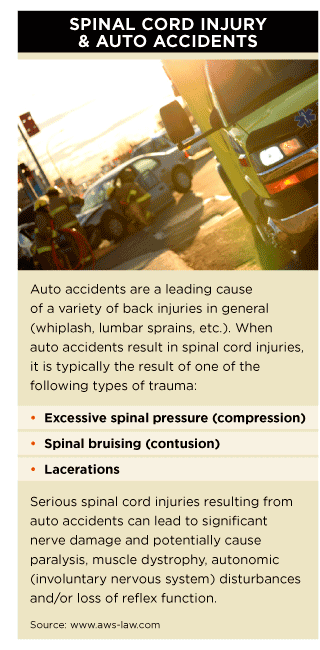Motor vehicle crashes no longer represent the leading causeof traumatic spinal cord injuries in the United States,according to a new report from Johns Hopkins. Instead, slip andfall incidents—especially among the elderly—now generate thelargest number of serious spinal injuries.
|The same research shows, moreover, that rates of theseinjuries—whose symptoms range from temporary numbness to full-blownparalysis—are rising fastest among older people, suggesting thatefforts to prevent falls in the elderly could significantly curbthe number of spinal injuries.
|The recent rash of severe weather affecting a large swathof the U.S. (and the resultant icy conditions on sidewalks andother common areas) mean that arguably more seniors will bevulnerable to falls.
|“We have demonstrated how costly traumatic spinal cord injury isand how lethal and disabling it can be among older people,” saysShalini Selvarajah, M.D., M.P.H., a postdoctoral surgical researchfellow at the Johns Hopkins University School of Medicine andleader of the study published online in the Journal ofNeurotrauma. “It's an area that is ripe for prevention.”
|For their study, the Johns Hopkins researchers analyzed anationally representative sample of 43,137 adults treated inhospital emergency rooms for spinal cord injury in the U.S.between 2007 and 2009. While the incidence among those aged 18 to64 ranged from 52.3 per million in 2007 to 49.9 per million in2009, the incidence per million in those 65 and older increasedfrom 79.4 in 2007 to 87.7 in 2009.
|Falls were the leading cause of traumatic spinal cord injuryover the three-year study period (41.5 percent), followed by motorvehicle crashes (35.5 percent). Fall-related spinal cord injuriesincreased during the study period overall. Among the elderly, theyincreased from 23.6 percent to 30 percent of injuries.
|The average age of adults with a traumatic spinal cord injury ina previous study that covered the years 2000 to 2005 was 41; thenew study suggests it is now 51.
|The investigators say that even when taking into account injuryseverity and other illnesses experienced by the patients, olderadults with traumatic spinal cord injury are four times more likelyto die in the emergency room from such an injury compared toyounger adults. If they survive and are admitted, they are sixtimes more likely to die during their inpatient stay.  While the researchers say they can't pinpointthe exact reason that falls have surpassed car crashes as a causeof traumatic spinal injuries, they believe it may be a combinationof the general aging of the population, the more active lifestylesof many Americans over 65, and airbags and seatbelt laws that allowdrivers and passengers to survive crashes.
While the researchers say they can't pinpointthe exact reason that falls have surpassed car crashes as a causeof traumatic spinal injuries, they believe it may be a combinationof the general aging of the population, the more active lifestylesof many Americans over 65, and airbags and seatbelt laws that allowdrivers and passengers to survive crashes.
“We are seeing a changing face in the epidemiology of spinalcord injury,” explains Edward R. Hammond, M.D., Ph.D., aresearch associate at the International Center for Spinal CordInjury at Kennedy Krieger Institute and another of the study'sleaders.
|Beyond the personal toll of disability and death, spinal cordinjuries are a growing financial burden on the health care system,the researchers say.
|They estimate that from 2007 to 2009, emergency room chargesalone for traumatic spinal cord injury patients totaled $1.6billion. But that is “just the first drop in a long-fillingbucket,” says Eric B. Schneider, Ph.D., an epidemiologist at theJohnsHopkins University School of Medicine's Center for Surgical Trialsand Outcomes Research. Those charges increased by 20 percentover the study period, far more than just the cost ofinflation.
|The spinal cord injuries captured by the data for this studywere those serious enough to land the patient in the emergency roomand included temporary bruising to severed or permanently damagedcords that cause paralysis, difficulty breathing, an inability tofill and empty the bladder and other motor disabilities.
|According to the National Spinal Cord Injury Statistical Center,lifetime costs of care for someone with a serious spinal cordinjury can range from $1 million to $5 million, depending on theage of the person at the time of injury and the severity of theinjury. Improvements in rehab care are leading to longer lifeexpectancy among patients with spinal cord injury — and biggermedical bills.
|“With so much emphasis on trying to reduce health care costsright now, this is another reason why preventing the injuryaltogether is so vital,” Selvarajah says.
|A recent campaign by the National Institutes of Health(NIH) is funding the search for better ways to prevent fallsthat lead to traumatic brain injury in the elderly. Schneider saysthe effort could also lead to a coincidental reduction in traumaticspinal cord injury.
|The spinal cord is a long bundle of nerve tissue that sitsinside a bony structure called the vertebral column or backbone. Itis the conduit that connects the brain to the rest of the body,enabling nearly all of the latter's functions.
|Other Johns Hopkins researchers involved in the study includeAdil H. Haider, M.D., M.P.H.; Christopher J. Abularrage, M.D.;Daniel Becker, M.D.; Nitasha Dhiman, M.S.P.H.; Omar Hyder, M.D.,M.S.; and James H. Black III, M.D.
Want to continue reading?
Become a Free PropertyCasualty360 Digital Reader
Your access to unlimited PropertyCasualty360 content isn’t changing.
Once you are an ALM digital member, you’ll receive:
- All PropertyCasualty360.com news coverage, best practices, and in-depth analysis.
- Educational webcasts, resources from industry leaders, and informative newsletters.
- Other award-winning websites including BenefitsPRO.com and ThinkAdvisor.com.
Already have an account? Sign In
© 2024 ALM Global, LLC, All Rights Reserved. Request academic re-use from www.copyright.com. All other uses, submit a request to [email protected]. For more information visit Asset & Logo Licensing.








